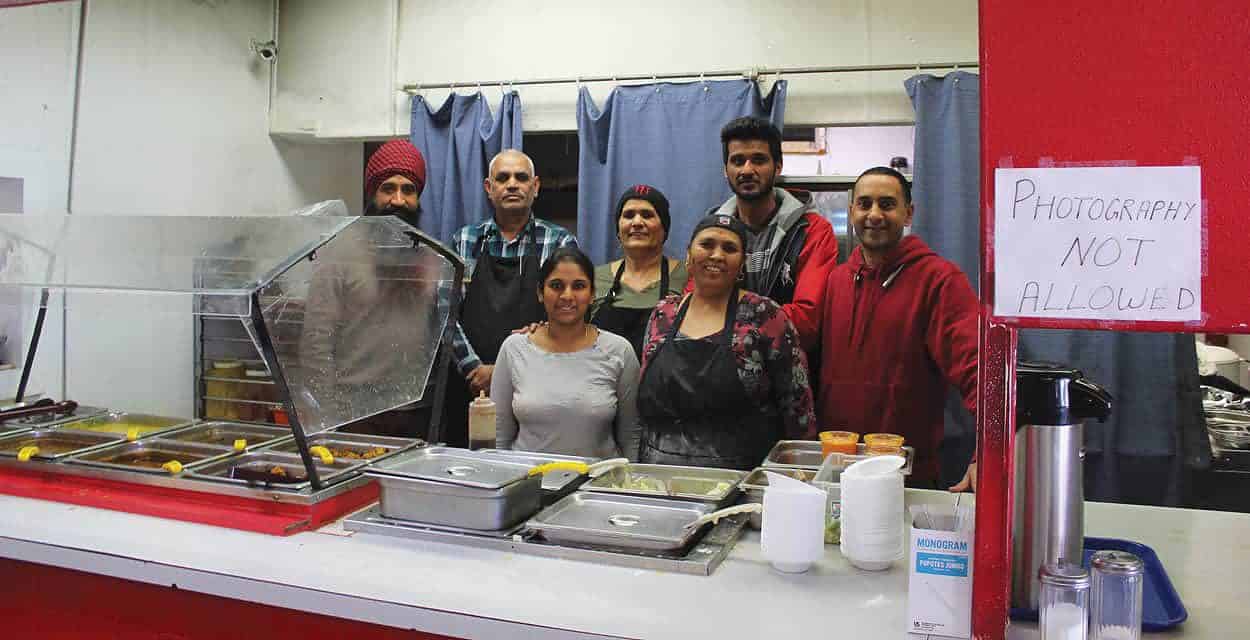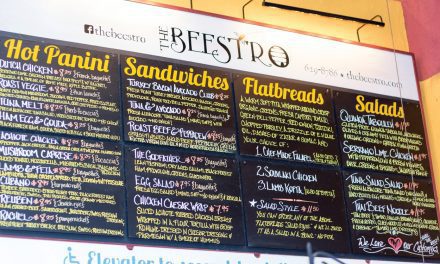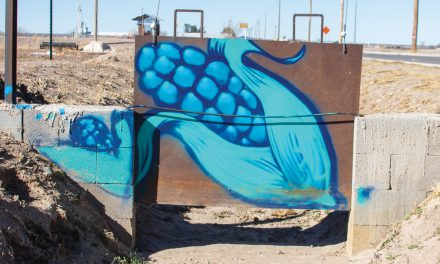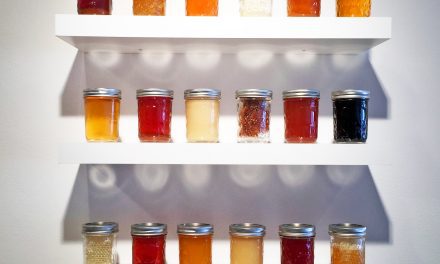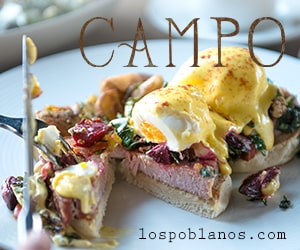Eating Like a Trucker on America’s Mother Road
By Willy Carleton · Photos by Joshua Johnson

Lakhbir Singh (far left) and the rest of the Taste of India kitchen crew at the Taste of India in San Jon, New Mexico. Opposite page: Bhan Kaur (left) cooking in the Truck Stop 40 kitchen and Raj Singh (right), owner of Truck Stop 40.
My empty stomach filled with dread as I considered my options along the expansive stretch of I-40 approaching the Texas panhandle. But then I filled up with gas at the Truck Stop 40 in western Oklahoma, twenty-six miles from the Texas border, and stopped into an unassuming restaurant in a large red garage marked with only a small white sign in Hindi and the words “Indian food” below it. I ordered at the small kitchen window and, five minutes later, received a steaming, made-to-order, savory cauliflower paratha and a homemade chai that, despite its styrofoam cup, rivaled any coffeehouse chai I’d had. That truck stop restaurant, and several others serving north Indian cuisine that I frequented as I drove beside the historic Route 66 on I-40 from western Oklahoma to Gallup, New Mexico, upended my expectations of road food. A surefire way to a great meal on the road, I learned, is to eat like a trucker. A Punjabi trucker.
The American highway, and the truck drivers who know it best, have long served as powerful cultural symbols in this nation. Ever since Walt Whitman’s “Song of the Open Road” on the eve of the American Civil War, Americans have cherished the opportunities of “the long brown path” as central to national ideals of freedom. As post-WWII America bankrolled an interstate highway system and Americans put their shoulders to the wheel, Nat King Cole immortalized this classic western stretch of American asphalt in song. Route 66, the epitome of romance and youthful possibility, became the Mother Road, the Main Street of America.
The American trucker has shared in the lore of the open road. In the popular imagination of the late twentieth-century, truckers had become modern iterations of the idealized hardworking, nomadic American cowboy. Like the cowboys of yore who drove herds from ranch to market along vast trails that cut across the West, the big-rig teamster symbolized independence and mobility. Countless country songs and popular films celebrated a stereotypically solitary and freewheeling owner-operator, a proud American working man who was always on the road. Just like cowboys, the trucker’s romantic appeal derived from a nostalgic sense that their way of life was vanishing at the hands of modern forces. By the late seventies, a host of writers had declared truck-driving men as “the last American cowboys.”

American truckers have not vanished, but their jobs, and demographics, have changed dramatically over the past four decades. The Teamsters union has lost its might and the percentage of single-truck owner-operators has steadily declined. Profit margins are tighter and hours on the road are longer than ever. Whereas in the 1970s the vast majority of truckers were US-born, today almost twenty percent of truckers are immigrants. This trend is increasing as trucking companies face more difficulty recruiting labor and, more than ever, recruit drivers from places like Punjab, India. Nearly thirty percent of foreign-born truckers come from either Asia or Europe, with most of the rest coming from Latin America.
After my meal at the Oklahoma truckstop, I asked the owner, Raj Singh, about its backstory. Singh told me he worked as a truck driver before opening the restaurant ten years ago. He noticed that an increasing number of Punjabi truck drivers had no good food options along this highway stretch. “I drove I-80, I-10, and I-40 before I figured out this is the right spot,” Singh explained. He also realized that to serve the entire Punjabi trucking community, he needed two restaurants in two separate buildings. “A lot of religious guys don’t trust a building that cooks meat,” he explained. “So people who are really religious, the people who don’t want eggs or meat, they come here.” We stood in the restaurant that serves vegetarian food. He motioned his head toward a building on the other side of the gas pumps. “Those that want meat, they go across the street.”
The following day I continued west and pit-stopped in San Jon, a tiny crossroads perched in the heart of dust-bowl country in far eastern New Mexico, where on all sides the distant horizon encircles a dry, brown, open landscape.
San Jon is home to some of the best Punjabi food in New Mexico. As I stepped into the Taste of India in the Friends Truckstop, it felt like entering any gas station. But soon aromatic wafts of fenugreek, cardamom, cumin, ginger, and mustard from the steaming buffet greeted me. I looked down the aisles at rows of food products from India—multiple brands of ghee, bottles of bitter melon juice, and bags of fried lentil snacks—alongside gear oil and fan belts. Loud Punjabi music emanated from the TVs in the brightly lit dining section. There, truckers, mostly young men in their twenties and thirties, and mostly wearing sweatpants, sandals, and turbans, sat at the eight red booths, quietly eating their meals.
I loaded a plate of lentils, potatoes, basmati rice, and curry at the buffet and sat at the last open booth. In addition to the buffet, which is open from 10am to 11pm daily, a set menu featuring lamb curry, garam masala, chicken biryani, and homemade chai is available twenty-four hours a day. The potato and cauliflower paratha is the “local” favorite.
After my meal, Lakhbir Singh, co-owner of the truckstop and restaurant, told me why he chose this solitary desert town. “There are a lot of Punjabi Sikh truckers that are always on the road,” Singh explained, “They don’t have this kind of food otherwise.” Many drivers, he told me, stop for a meal once or twice a week, as they crisscross the country. The majority of customers are Punjabi, he said, but truckers of all ethnicities and a steady stream of cross-country motorists frequent the spot.

Truck Stop 40 in Sayre, Oklahoma.
Singh strives to provide the best possible food for his customers. Originally a farmer in India, he grew mixed vegetables ranging from ginger and turmeric to beets, rice, sugarcane, wheat, and corn. He splits time in New Mexico with a co-owner, who otherwise lives in India, and when Singh is not in New Mexico, he tends to an almond farm he owns in California. He said he hopes to start growing vegetables in New Mexico for the local community and for his truckstop restaurant. “Two or three acres would be fine,” he said. “The local people here need good, locally produced food.”
Continuing west, the next option for truckstop Punjabi fare is over three hundred miles away in Gallup. There, former truck driver Perminder Singh started the Bombay Restaurant and Grill at the USave Truckstop, off exit 16, in 2011. Although he started it to meet the demand from Punjabi truckers, he soon noticed that a diverse local clientele frequented the eatery. “People come from sixty miles around because it’s the only place to get Indian food.”
Common to each truckstop, beyond the north Indian fare and large TVs with loud Punjabi programming, is a welcoming, receptive spirit from the owners and waitstaff. The owner of each restaurant I visited graciously took the time to sit and tell me his story, and the servers all offered genuine smiles as they picked up my dirty plates. The friendly vibe, sadly, felt novel in the gas-station atmosphere, filled largely with strangers from elsewhere going somewhere far away.
A close look at this stretch of the Mother Road, beyond the nostalgic neon signs of long-gone burger shacks that still dot the old road, reveals new life on the same open road that has stretched before the American imagination for centuries. Tucked away in unassuming garages beside the windswept plains along America’s central artery, these highway eateries offer a quintessential American cuisine. They express our collective identity, despite current backlash, as a nation of immigrants, and illustrate the “profound lesson of reception” of Whitman’s open road. Next time you hit this stretch of asphalt, consider leaving the sandwiches at home and go get your kicks, and paratha, on Route 66.
Edible celebrates New Mexico's food culture, season by season. We believe that knowing where our food comes from is a powerful thing. With our high-quality, aesthetically pleasing and informative publication, we inspire readers to support and celebrate the growers, producers, chefs, beverage and food artisans, and other food professionals in our community.

